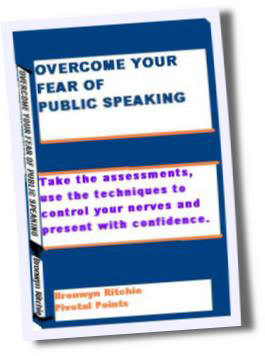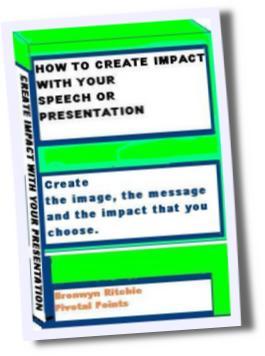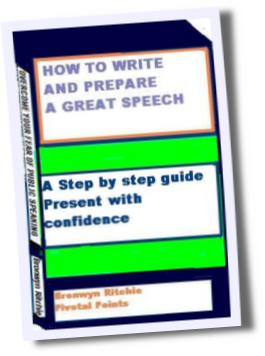Creating an impact with your presentation: consider the audience
Why are you giving this speech? What do you hope to achieve with your presentation?
What sort of impact do you want to create? What will that “WOW” be?
In creating that “WOW”, that impact, one of the most important steps will be to research and consider the audience, because unless they understand what you are saying and respond to it, there can be no impact, no WOW.
Before you can even start to plan what to say and how to say it, you will need to know as much as you can about that audience – their likes and dislikes, their needs and values, what they hope to take from your presentation. You will need to explore age, sex, income bracket, lifestyle as well as needs, wants and ambitions.
Of course this may not always be possible - it may be that when you stand to speak and connect with the audience, you have to assess them, then and there. And in that moment and those following, you will need to adjust your material and presentation accordingly. Your planning, of course, will have taken this into account.
But there may be opportunities before the presentation to assess the audience. When they register for the event you could gather details. After they register you can send a questionnaire. Use this opportunity to also ask for any questions they particularly want answered and this will help your planning even more.
If at all possible, mingle with the attendees before your presentation. This gives you a chance to get to know them and their likely patterns of response. (It will also give them a chance to get to know you … and … you the opportunity to warm up your voice before the speech!)
Then, when you have conducted your assessment, you can fine-tune your presentation to create the impact you desire.
The content of your speech or presentation can be designed to respond to their needs and wants – provide the answers they wanted, provide the motivation they needed. You might choose to stimulate creative thinking for them, provide alternative options for them, based on your research of their interests and needs. That would certainly create an impact!
You may want to present yourself, both through your image and your content, as something your audience can aspire to, if that would provide an answer to their dreams and aspirations.
At the very least, your image should be chosen to be inoffensive to your audience. If possible you can research what they are likely to be wearing, and dress according to their code and culture, or a step higher in terms of formality, or business. You can create a WOW with your image, either by fitting in with your audience’s tastes or by impressing them. You can impress by creating an image that supports your message, and that sells you as the person you want the audience to see – trustworthy, honest, sincere or maybe exciting, mystical – whatever will support your message and the impact you want to create. But it will only create that impact, that WOW, if you tailor it to your audience – their likes, dislikes, tastes, values and culture.
Your language structure and vocabulary can be crafted to make the audience feel that you speak their language. And this will be based on factors like age, educational level, occupation, and lifestyle.
You can also ensure two other things - that your language doesn‘t provide offense and that it can be easily understood.
Otherwise, not only will you not create an impact; people will simply tune out and you will also have destroyed your personal credibility. So make your material; your anecdotes, your humour and your explanations; as well as your image, appropriate to your audience’s sensibilities and their levels and areas of understanding. Confine your jargon and vocabulary to words the audience feels at home with and you will maximize their understanding of your message and the impact you can create.
Successful speech-makers consider their audience in as much depth as they can, and use that as an integral part of the planning for their presentations. Use this tool when you speak, and you too, can create that impact, that WOW.
© 2005 Bronwyn Ritchie All rights reserved. If you would like to use this article, you have permission to use it only in full, and with the following Resource box attached.
Bronwyn Ritchie AALIA AC(ITC) is a librarian, an award-winning public speaker and ITC-certified trainer - For more resources on public speaking, visit http://www.consultpivotal.com/public_speaking
Sunday, February 26, 2006
Thursday, February 23, 2006
You're not stuck with your voice
Despite What You Think, You’re Not Stuck With Your Voice
by Susan Berkley
Nor should you take it for granted. Your voice can have a profound impact on how successfully you influence and persuade others. Your voice effects how seriously you are taken... how respected you are... the results you get with clients, co-workers or vendors in business, with lovers or spouse and children in your personal life.
Your voice can be a powerful secret advantage you very deliberately use for influence and persuasion (just as actors and people paid thousands of dollars per minute to record commercials do)—or it can be a handicap (like it was for Markus on The Apprentice), undermining the impact of everything you say.
Here’s why.
Article continues
by Susan Berkley
Nor should you take it for granted. Your voice can have a profound impact on how successfully you influence and persuade others. Your voice effects how seriously you are taken... how respected you are... the results you get with clients, co-workers or vendors in business, with lovers or spouse and children in your personal life.
Your voice can be a powerful secret advantage you very deliberately use for influence and persuasion (just as actors and people paid thousands of dollars per minute to record commercials do)—or it can be a handicap (like it was for Markus on The Apprentice), undermining the impact of everything you say.
Here’s why.
Article continues
Tuesday, February 21, 2006
Public Speaking success Tip - articulation
If you want to get a message across, people need to be able to hear it, to be able to hear each word. That means articulating every word very clearly. So pay particular attention to beginnings and especially endings. Then there can be no confusion between similar words such as taken and taking, or pass and past.
Tuesday, February 14, 2006
Three essential body language tips
From the One Minute Pause Blog
For anyone who has done some training with me, you’ll know that I don’t focus on body language when presenting. People can get obsessed by trying to look convincing or slick, and neglect the content of their presentation. They perform all the textbook hand gestures, and what comes out of their mouths doesn’t match up. A bit like watching 100 chavs pour out of a limo. It just doesn’t seem right.
Sometimes however I do give advice on body language for presenting - especially when it detracts from the message. Here are the 3 biggest body language presentation pitfalls, and what you can do to avoid them:
1. EYES
Sharing eye contact around the room is one of the best presentation delivery skills you can have. Meeting people’s eyes is crucial for maintaining audience interest. As an audience member we feel that you are actually talking to us - rather than talking to the PowerPoint screen or to the table.
So, what prevents you from maintaining eye contact with everyone? Well one of the reasons could be the Sympathy Nodder - the only person in the room who is nodding and paying you attention. When you’re presenting you usually gravitate towards attention and recognition. Even if you suspect someone is sympathy nodding, you probably don’t care. You will choose the Sympathy Nodder over the guy making a pen pyramid any day. So you direct your attention almost solely to that one person. This means that you have alienated the audience in favour of the Sympathy Nodder, who is probably concentrating more on nodding than listening.
In the name of research from the audience side, try the Sympathy Nod Experiment during your next boardroom presentation. Look the presenter dead in the eye and nod a couple of times. Repeat about 5 times per minute, or whenever they look at you. You will undoubtedly find the presenter draw their attention towards you, almost as if you are the only person in the room. A cruel experiment perhaps, but one which will prove to you that as a presenter you must resist the one person who seems to be giving you the attention and maximise your eye contact with everyone.
2. HANDS
One of the greatest problems you might have is knowing what to do with your hands. Quite strange really given that you never have to worry what to do with your hands when you are chatting to friends. Suddenly they become a big issue when presenting.
You have two options. You can spend thousands getting personal coaching and practicing 20+ hand gestures, such as the ‘chop’, the ‘opera singer’ or the ’sweep’, until they seem natural. Or you can hold a pen, with one or two hands. This sounds very simple, but it does the job, keeping your hands steady, professional and relaxed. With the money you save on personal coaching, you can buy yourself a better pen.
3. STANCE
There have been many books written on stance and posturing. Most of them are of little use. The best thing to remember is to stand with your feet pointed towards the audience. This solves a very big presentation skills problem, which is turning your back on the audience - such as when you are reading off PowerPoint. If you keep your feet pointed towards the audience then you be naturally inclined to twist back to face them.
For anyone who has done some training with me, you’ll know that I don’t focus on body language when presenting. People can get obsessed by trying to look convincing or slick, and neglect the content of their presentation. They perform all the textbook hand gestures, and what comes out of their mouths doesn’t match up. A bit like watching 100 chavs pour out of a limo. It just doesn’t seem right.
Sometimes however I do give advice on body language for presenting - especially when it detracts from the message. Here are the 3 biggest body language presentation pitfalls, and what you can do to avoid them:
1. EYES
Sharing eye contact around the room is one of the best presentation delivery skills you can have. Meeting people’s eyes is crucial for maintaining audience interest. As an audience member we feel that you are actually talking to us - rather than talking to the PowerPoint screen or to the table.
So, what prevents you from maintaining eye contact with everyone? Well one of the reasons could be the Sympathy Nodder - the only person in the room who is nodding and paying you attention. When you’re presenting you usually gravitate towards attention and recognition. Even if you suspect someone is sympathy nodding, you probably don’t care. You will choose the Sympathy Nodder over the guy making a pen pyramid any day. So you direct your attention almost solely to that one person. This means that you have alienated the audience in favour of the Sympathy Nodder, who is probably concentrating more on nodding than listening.
In the name of research from the audience side, try the Sympathy Nod Experiment during your next boardroom presentation. Look the presenter dead in the eye and nod a couple of times. Repeat about 5 times per minute, or whenever they look at you. You will undoubtedly find the presenter draw their attention towards you, almost as if you are the only person in the room. A cruel experiment perhaps, but one which will prove to you that as a presenter you must resist the one person who seems to be giving you the attention and maximise your eye contact with everyone.
2. HANDS
One of the greatest problems you might have is knowing what to do with your hands. Quite strange really given that you never have to worry what to do with your hands when you are chatting to friends. Suddenly they become a big issue when presenting.
You have two options. You can spend thousands getting personal coaching and practicing 20+ hand gestures, such as the ‘chop’, the ‘opera singer’ or the ’sweep’, until they seem natural. Or you can hold a pen, with one or two hands. This sounds very simple, but it does the job, keeping your hands steady, professional and relaxed. With the money you save on personal coaching, you can buy yourself a better pen.
3. STANCE
There have been many books written on stance and posturing. Most of them are of little use. The best thing to remember is to stand with your feet pointed towards the audience. This solves a very big presentation skills problem, which is turning your back on the audience - such as when you are reading off PowerPoint. If you keep your feet pointed towards the audience then you be naturally inclined to twist back to face them.
Thursday, February 09, 2006
Tips for keeping your cool before your presentation
Stretch to relax. Rise on your toes and reach for the ceiling, with your head back. Tighten your muscles from legs up through abdomen, and then release. Relax the neck and shoulder muscles, letting head loll on neck in different directions.
Breathe to relax. Stand erect, but relaxed and balanced. Inhale while silently counting to five. Hold the breath for five counts, then exhale for five – all breathing is through the mouth. Your diaphragm should move, but your chest should not expand. You can gradually increase the number of counts for each breath to 10.
Relax your Jaw. Let your head loll forward. As you raise it, keep your jaw relaxed. Let it hang open, and smile to yourself at how silly it feels.
Relax your throat. Yawn …. This is how your throat needs to be to speak well – open, and relaxed.Keep relaxing the muscles throughout your body, your jaw, neck and throat until you walk to the presentation area. Then smile! and begin.
Sunday, February 05, 2006
Energise your powerpoint opening slide
Jazz up your PowerPoint opening title slide -- Marilyn Snyder(Marilyn@InteractiveConceptsOnline.com)Want a jazzy animation in your opening slide? Create your titlein WordArt and animate it so that it stretches out from thecenter very fast. Then duplicate that WordArt five or six times.Wow! Here's how to animate in PP2002/03: Click on the WordArt,select Add Effect, Entrance, More Effects, Stretch. Duplicate theWordArt quickly by selecting it and pressing Control + D five orsix times. Change the Start effect to After Previous.
Thursday, February 02, 2006
Pivotal Speaking Success Tip
If you speak in a monotone, you will lose the audience. They will be bored. Add excitement by varying your pitch. You can also use change in pitch, volume and speed to emphasize new or important ideas.
Subscribe to:
Posts (Atom)




